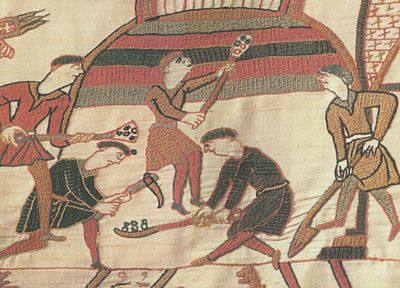Book Review

JAMES GRAHAM-CAMPBELL with MAGDALENA VALOR (ed.). The archaeology of medieval Europe, volume 1: eighth to twelfth centuries AD (Acta Jutlandica LXXXIII:1, Humanities Series 79). 479 pages, numerous b&w & colour illustrations. 2007. Aarhus: Aarhus University Press; 978-87-7934-288-0 hardback £ 50, €75 & $90; 978-87-7934-290-3 paperback £ 35, €51.50 & $60.
Review by Joëelle Burnouf
Université de Paris 1 Panthéon Sorbonne, UMR 7041 ArScAn "Archéologies Environnementales", Paris, France
(Email: joelleburnouf@orange.fr)
(Translated from the French by Reviews Editor)
In 1999, at an international conference of the European Symposium of Teachers of Medieval Archaeology (ESTMA) in Seville, Else Roesdahl proposed to produce a work which would allow European students to appreciate and comprehend medieval archaeology in Europe, a discipline which has expanded immensely over the last 50 years. Here, eight years after the idea was first mooted, we review Volume 1 of this two-volume project: it covers the high Middle Ages (eighth-twelfth centuries AD).
No fewer than eight separate institutions have supported this project: the Augustinus Foundation, the Universities of Prague (Charles University, Faculty of Philosophy and Arts), Galway, Ghent (Department of Archaeology), Lund (Faculty of Humanity and Theology), Seville (HUM-712), Aarhus (Department of Medieval and Renaissance Archaeology), and the Aarhus University Research Foundation.
The authors assembled do not entirely cover the whole of Europe: rather they represent networks of academic medievalists. Of the 41 contributors, 7 are Danish, 7 British, 5 German, 5 Spanish, 3 Polish; Italians, Norwegians, Czechs and Irish field two authors each, while single authors carry the torch for Sweden, Belgium, Austria, France, Finland and Iceland. For those who follow medieval archaeology, this panel differs in composition from other such panels, for example that of the European Association of Archaeologists. It may well be worth reflecting in future on the path medieval archaeology has followed, not only from a scientific point of view, but also in terms of the professional and research fields opened in the last decade.
The volume aims to show how the discipline has renewed itself. Several meetings took place between 2001 and 2004 in a number of European cities where it was agreed that two authors would take charge of each of the 15 chapters and that 'boxes' would contain more precise indications on sites or themes only touched on in the main text.
Else Roesdahl's preface sets out the genesis of the work since 1999 and the philosophy behind the undertaking, while Graham- Campbell's introduction (pp. 13-18) serves as a user's guide explaining the geographical and chronological frameworks and the theoretical bases which underpin the chapters; these are constructed from many recent studies - taken as works of reference - which have sprung from collective research projects such as the European Transitions from the Roman World (TRW) programme (the latter unfortunately contained little archaeology and hardly any interdisciplinary dialogue). Graham-Campbell also clarifies the chronological synchronisation of the medieval period in the various countries of Europe.
The layout follows a classic thematic scheme with 15 chapter of roughly equal length supplemented by boxes, illustrations and a short bibliography. The book ends with three indices: of authors, people and places, and a general index.
This work sums up the beginnings of medieval archaeology in Europe but it cannot encompass (except in a few chapters) the huge wealth of information gained by new research undertaken in the last twenty years or so, reported in a plethora of university dissertations and excavations reports brought about by the formidable increase in development in Europe. It may be that other ways of structuring the volume, through presentation and discussion of results, could have better demonstrated how medieval archaeology can write 'another history of the Middle Ages'. Thus, in the chapter on elites, a regrouping of references to the various markers of power in Europe (spread over chapters 5, 11 and 12 for civilian elites, and chapters 13, 14, and 15 if we add the ecclesiastical elites) could have led to a reflexion on manifestations of power, as much in their standard form as in their 'regional' variations. Similarly, when considering the relationship between societies and their environment - leaving aside the fact that over the 'longue durée' of the medieval millennium there is no attempt to consider the 'legacies' of earlier periods (one of the strong points of current research) - interdisciplinary research has demonstrated that all that pertains to the exploitation of animal and plant resources, i.e. agriculture but also industry, is relevant to a fundamental reflexion on global environmental matters; this could have been highlighted by re-grouping data, for example those in chapters 1, 6 and 7. Indeed the Middle Ages are particularly suited to such studies since the period experienced three climatic downturns, in the sixth century, at the beginning of the ninth century and at the onset of the Little Ice Age in the fourteenth century.
This volume will undoubtedly prove useful to students and may entice them to consult the primary literature, dissertations and specialist works; it may also inspire them to work on one or other research topic at a Europe-wide scale.



